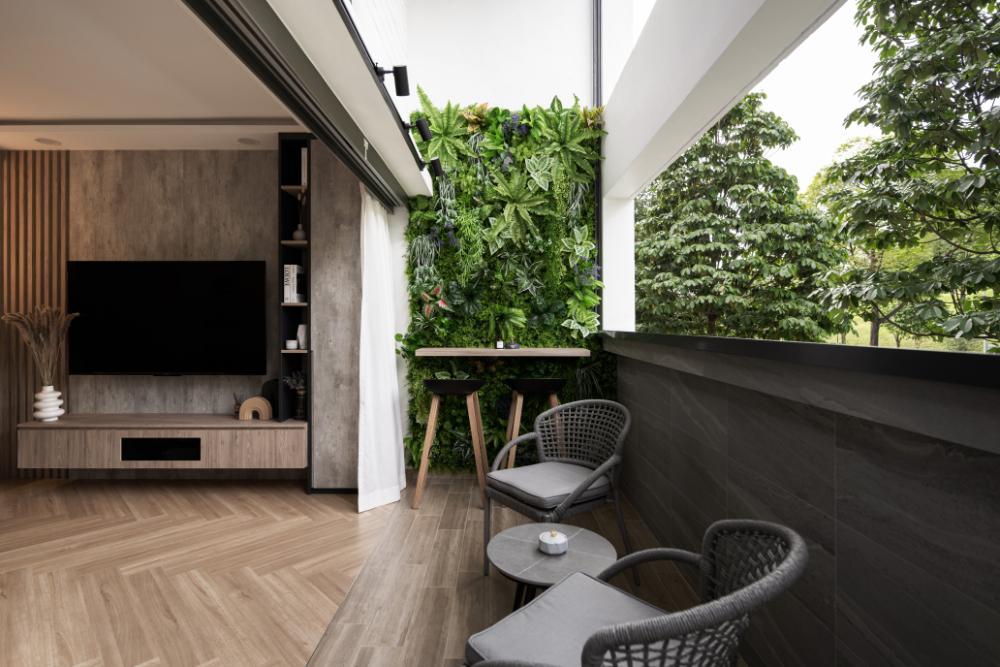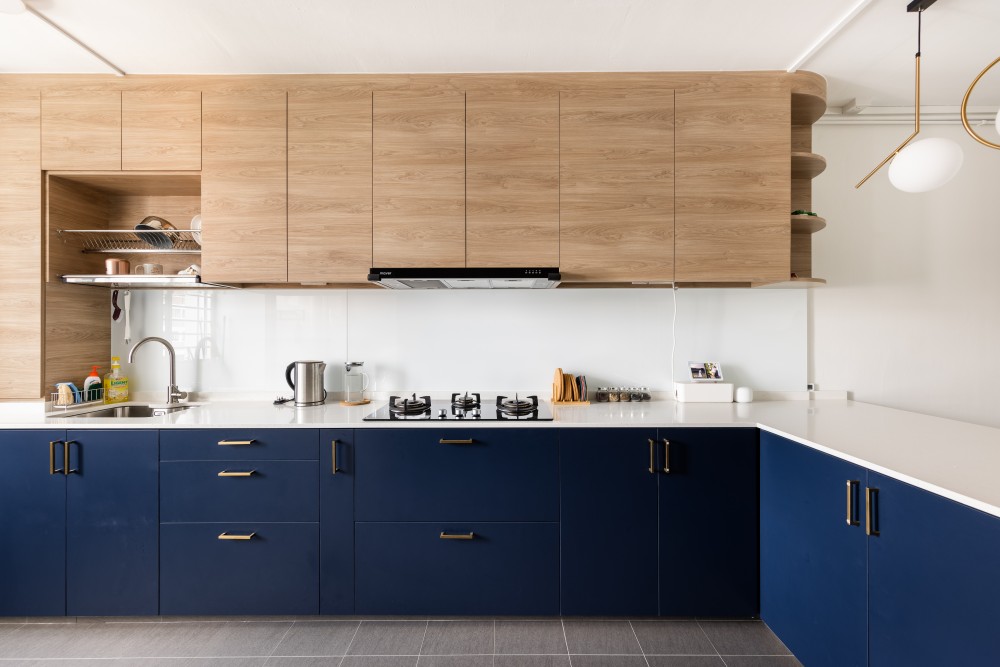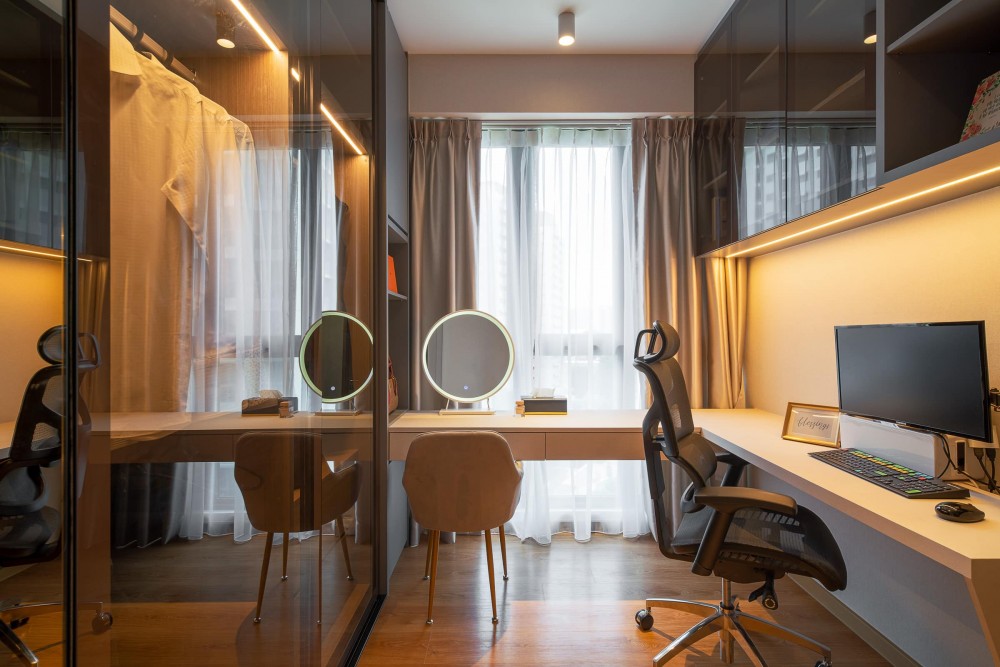The Ultimate Guide to Renovating in the Scandinavian Style
Scandinavian design has become a beloved interior style worldwide, and it’s no wonder why. Known for its clean lines, simplicity, and focus on functionality, this aesthetic transforms homes into serene, inviting spaces.
In Singapore, where space is often limited, the light and airy qualities of Scandinavian design make it particularly appealing.
In this guide, we’ll walk you through everything you need to know to renovate your home in the Scandinavian style.
Understanding Scandinavian Design Principles
At its core, Scandinavian design is all about balance – combining minimalism with warmth and practicality. This approach creates spaces that are both functional and inviting, making it an enduring favorite for home interiors. Here are some key principles to guide your renovation:
Simplicity and Functionality
Scandinavian design champions the mantra “less is more.” Each element in your home should serve a purpose, whether functional, aesthetic, or both.
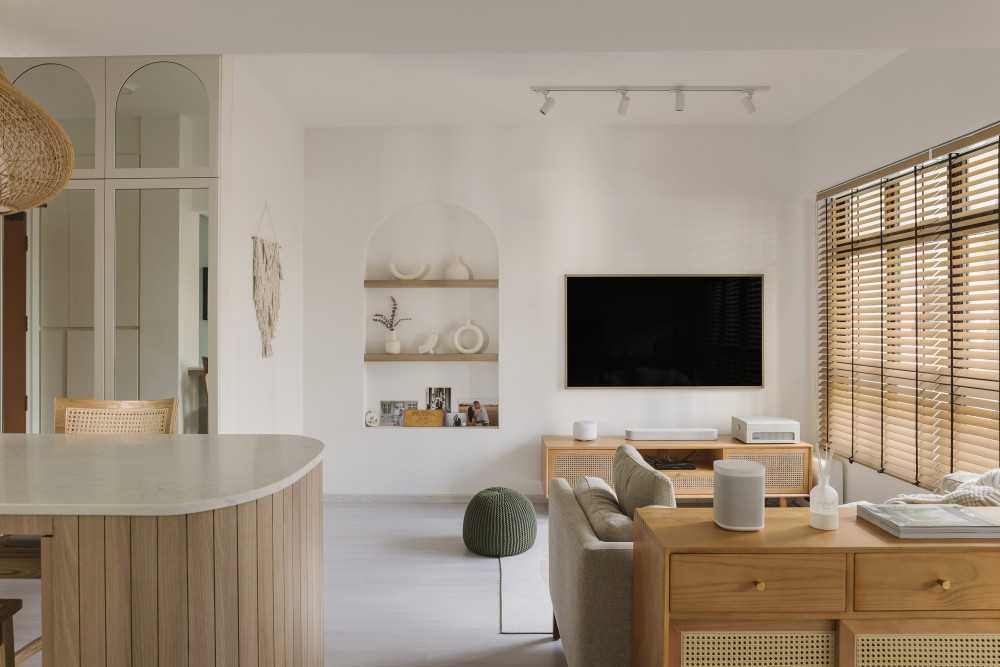

114B Alkaff Crescent ($80,000) by The Interior Lab Pte Ltd
Furniture is often multi-functional, such as storage ottomans or extendable dining tables, making it ideal for small spaces like Singaporean apartments.
The goal is to eliminate clutter and create a streamlined, organized space where every piece contributes to the overall design.
Neutral Color Palettes
The hallmark of Scandinavian interiors is their calm and serene atmosphere, achieved through neutral tones.
Whites, soft greys, beiges, and pastel accents are key, creating a bright and cohesive look. These colours reflect natural light, making spaces feel larger and more open – perfect for compact homes.
While neutral shades are the base, you can add character with subtle pops of colour, such as muted blues or dusty pinks, in your accessories or artwork.
Natural Materials
A connection to nature is a cornerstone of Scandinavian design. Incorporate natural materials like light-toned woods (think ash, birch, or pine), stone finishes, and organic textiles like cotton, wool, or linen.


114B Alkaff Crescent ($80,000) by The Interior Lab Pte Ltd
These materials add texture and warmth, grounding the minimalist design in an earthy, welcoming feel. For example, pair a wooden dining table with linen curtains and soft cotton cushions for a layered, inviting aesthetic.
Light and Airy Spaces
Maximizing light is critical in Scandinavian homes, given the long, dark winters in the Nordic countries. Large windows are typically left unobstructed or dressed in sheer curtains to allow as much light as possible to flood the space.
In Singapore, where natural light is abundant, you can lean into this by choosing bright, reflective surfaces such as light-coloured walls and glossy finishes. Strategic use of mirrors can further amplify light, creating a breezy and open environment.
Hygge Elements
“Hygge” (pronounced hoo-gah) is a Danish concept that embodies coziness and comfort. In Scandinavian interiors, this translates to incorporating soft, tactile elements like plush throw blankets, oversized cushions, and thick rugs.
Warm, ambient lighting from table lamps or candles also adds to the hygge atmosphere, making the space feel inviting and relaxing. While the overall look remains minimal, these elements ensure the home feels lived-in and comforting.
Key Features of a Scandinavian Renovation
To truly embrace the Scandinavian aesthetic, it’s essential to focus on its foundational elements, which together create the hallmark minimalist, warm, and functional spaces this style is known for. Here’s how to incorporate them effectively into your home:
Wood Floors
Light wood or wood-look vinyl flooring is a cornerstone of Scandinavian interiors, offering a bright, open foundation for the entire space.
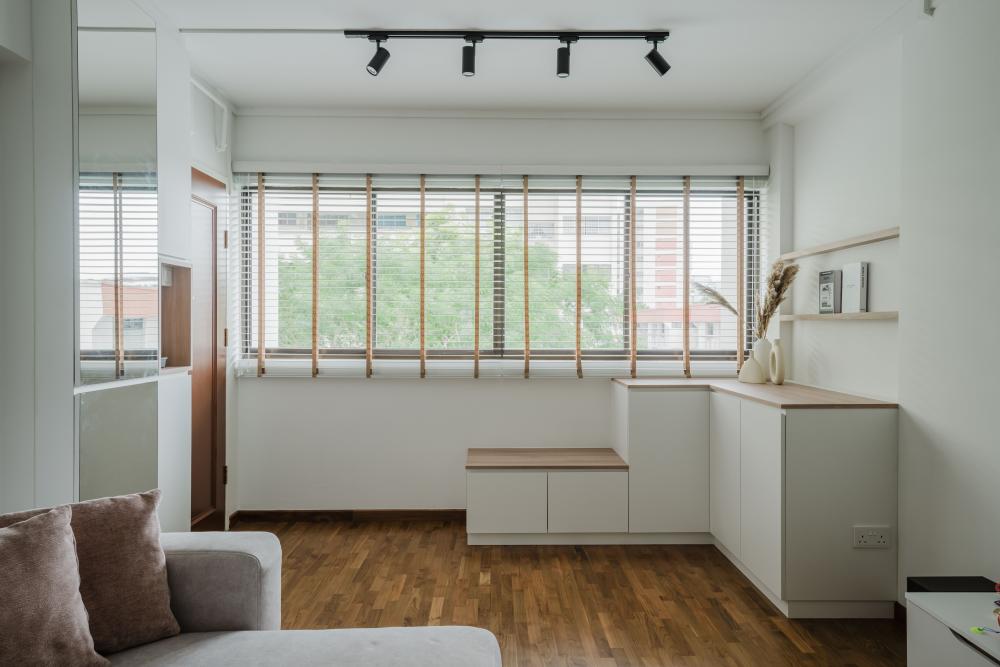

241 Tampines St 21 ($48,000) by 9 Creation Pte Ltd
Light tones such as ash, birch, or pine add a natural warmth and create the illusion of larger spaces, and are ideal for compact Singaporean apartments.
If solid wood floors are out of your budget, wood-look vinyl is an excellent alternative. Modern options are impressively realistic, mimicking the texture and appearance of natural wood at a fraction of the cost.
As a bonus, wood-look vinyl is highly practical for Singapore’s humid climate, as it resists warping and requires minimal maintenance.
Neutral Walls
The walls in Scandinavian homes are typically painted in neutral shades like white, off-white, or light grey, which reflect natural light and create a serene atmosphere.
For added depth, consider textured wallpapers with subtle patterns, such as linen textures or muted geometric designs. These can add visual interest without disrupting the overall calmness of the space.
If you prefer a splash of colour, a single feature wall in a soft pastel hue like sage green or dusty blue can serve as a gentle focal point.
Simple and Functional Furniture
Furniture is at the heart of Scandinavian design and should embody simplicity, functionality, and craftsmanship. Look for pieces with clean lines, natural wood finishes, and soft, muted upholstery in fabrics like linen.
Multi-functional furniture, such as a storage ottoman or a sofa bed, is particularly useful in Singapore’s smaller homes.
Avoid overly ornate designs; instead, focus on timeless, durable pieces that blend aesthetics with practicality. A natural wood dining table paired with upholstered chairs in neutral tones, for example, can create a cozy yet elegant dining area.
Warm and Cozy Lighting
Lighting is a key component of Scandinavian interiors, where the focus is on creating warmth and coziness through layered lighting.
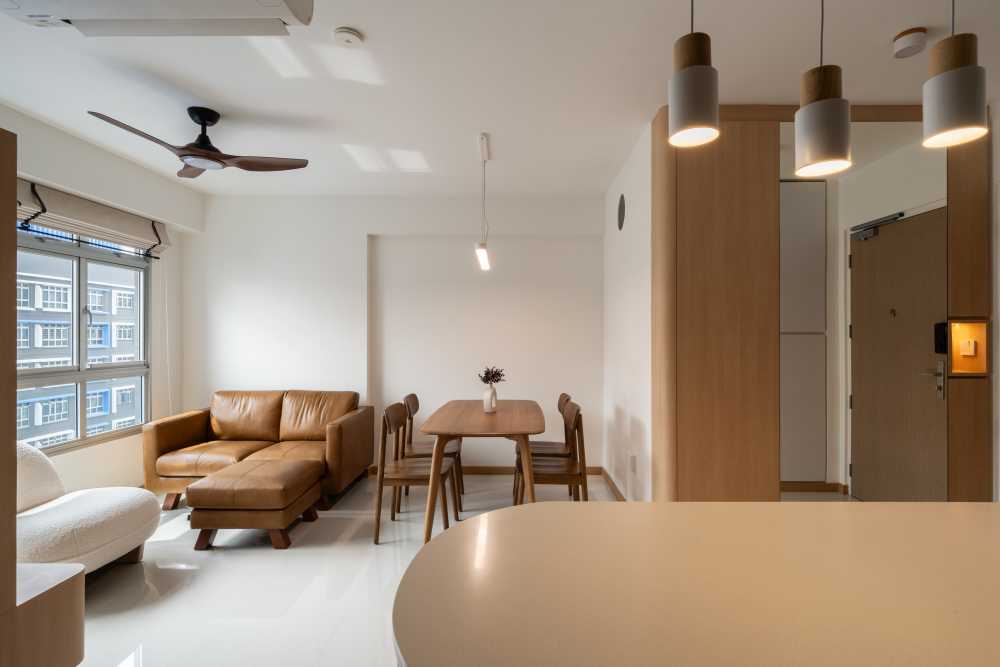

Kallang Breeze ($55,000) by Design 4 Space Pte Ltd
Start with overhead fixtures such as simple pendant lights or sleek, modern chandeliers in natural or metallic finishes. Complement this with floor lamps and table lamps, choosing designs that incorporate natural materials like wood or fabric.
Candles are another essential element, adding a soft, flickering glow that enhances the hygge (coziness) vibe. In Singapore, where daylight is abundant, keep window treatments light and airy to maximize natural light.
Storage Solutions
Clutter-free spaces are essential to achieving the Scandinavian aesthetic.
Invest in smart storage solutions such as built-in cabinets or floating shelves that blend seamlessly with your walls. Furniture with hidden storage, like a bed frame with drawers or a coffee table with compartments, helps maintain the minimalist look without sacrificing practicality.
Open shelving can also work if styled thoughtfully with neatly arranged books, plants, or neutral-toned ceramics to avoid a cluttered appearance.
Designing Your Space to Maximize Functionality
We’ve discussed how Scandinavian design is deeply rooted in functionality, but how do you go about maximizing functionality in your home?
Start by considering your unique needs and lifestyle, and then go from there:
Step 1: Assess Your Current Situation and Lifestyle
Before making any changes, take a good look at your current living situation.
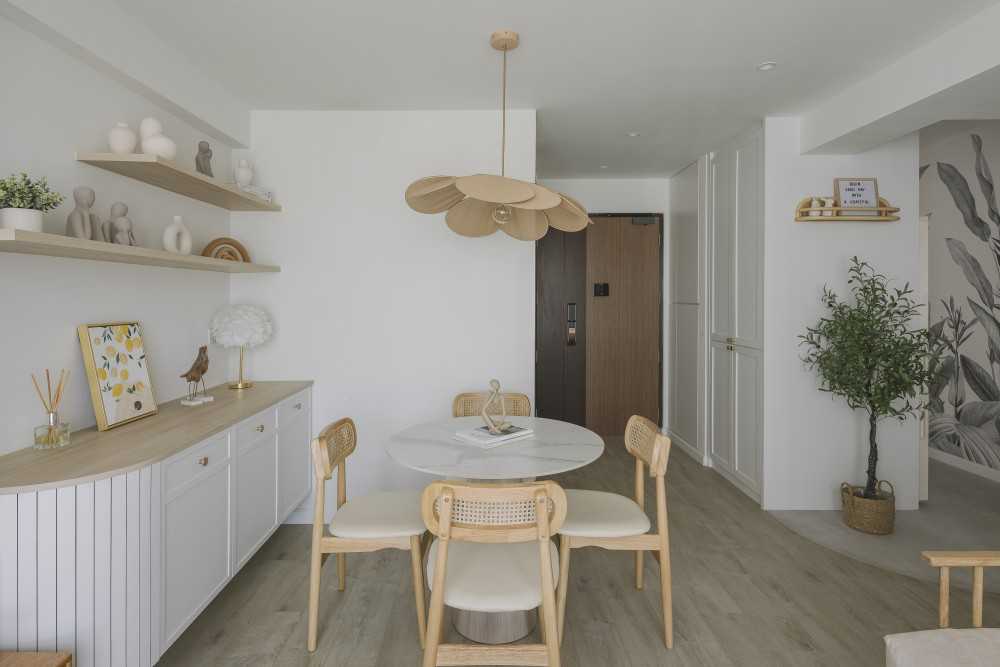

37A Pine Lane ($100,000) by The Interior Lab Pte Ltd
Think about how you use each space and how you move through your home. Do you entertain often? Do you need more storage? Are there certain activities that feel cramped or disorganized?
These considerations will help you pinpoint areas that need improvement.
Step 2: Identify Pain Points
Once you’ve assessed your space, pinpoint any pain points that disrupt your daily life.
Do you struggle with storage? Do certain areas feel cluttered or chaotic? Identifying these problem areas is key to designing a more functional layout.
Step 3: Look for Smart Solutions
Search for design ideas on platforms like Pinterest or browse through interior design firms’ social media to find inspiration. Look for practical solutions that can alleviate the pain points you identified.
Scandinavian design is all about smart, simple solutions that don’t sacrifice style. Here are some examples:
- If you find your kitchen counter cluttered with small appliances, consider adding built-in pull-out shelves or compartments where you can store your blender, toaster, or microwave. This will keep your counters clean and organized while making the appliances easily accessible.
- If you need to work from home but don’t have a dedicated office space, design a hidden desk that can be tucked away when not in use. You can install fold-down desks or retractable workstations that allow you to create a workspace without compromising your living area.
- If your dining space is limited, a foldable wall-mounted dining table is an excellent solution. It can be folded down for meals and folded back up when not in use, saving valuable space.
- If you need more shoe storage, consider those vertical rotating shoe racks that can turn both ways. These save space and allow you to easily access more shoes without having to dig through piles or multiple shelves.
- If you need to create separate zones in a small apartment, consider using room dividers that also serve as storage units. For example, a bookshelf or a unit with built-in shelving can divide a room while providing extra storage for books, decor, or other essentials.
What’s the Difference Between Scandinavian and Japandi?
Scandinavian and Japandi designs are often compared, as they share similar minimalist principles and a focus on creating serene, functional spaces. However, there are key differences that set them apart.
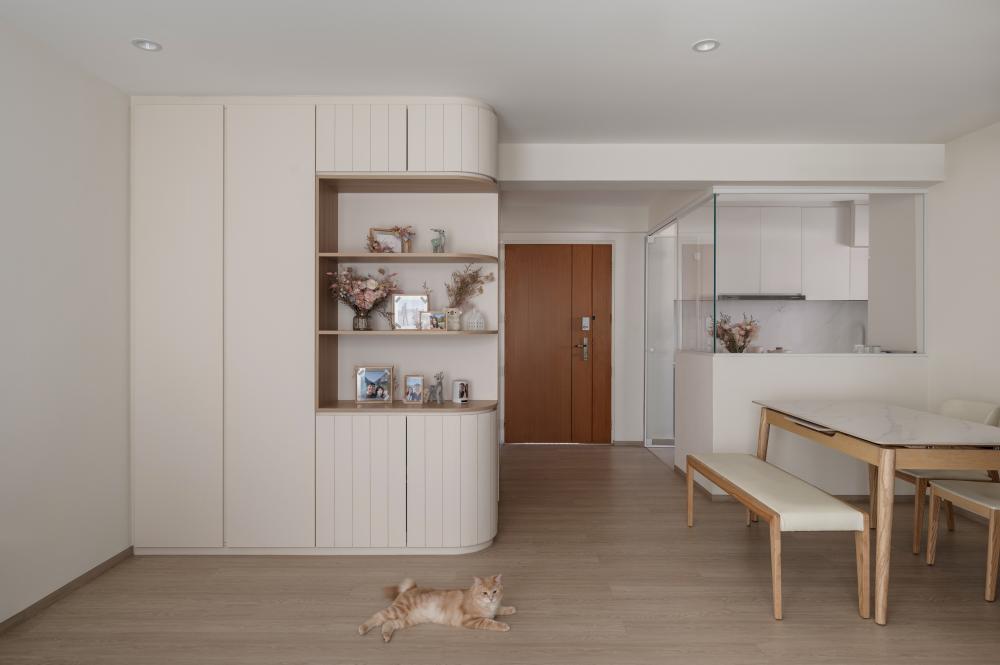

Compassvale Bow 1 ($55,000) by PRDT Pte Ltd
Here’s a breakdown to help you understand how each style differs in terms of aesthetics, influences, and design elements.
Cultural Influences
Since Scandinavia encompasses the Nordic countries (Denmark, Sweden, Norway, and Finland), its design is heavily influenced by the region’s harsh winters, which highlight the need for warmth, light, and practicality. The focus is on creating inviting, functional spaces with simple, natural materials.
As for Japandi design, this is a blend of Japanese and Scandinavian influences that combines the clean, minimalist lines of Scandinavian design with the quiet elegance and craftsmanship of Japanese interiors. Japanese design emphasizes simplicity, the appreciation of natural beauty, and a sense of tranquility.
Color Palette
Scandinavian interiors often feature light, neutral tones like whites, grays, and pastels, creating a bright and airy atmosphere. Pops of colour can be added, but they’re usually subtle and based on natural elements.
While Japandi interiors also use neutral colours, Japandi tends to favor deeper, earthy tones like charcoal, black, and warm neutrals such as beige, taupe, and brown. The focus is on creating a more grounded, natural feel, often enhanced by elements like dark wood and stone.
Materials
Scandinavian interiors are known for their use of light woods (like pine, oak, and birch), as well as natural textiles like linen, wool, and cotton. The materials reflect the region’s connection to nature and the outdoors.
Japandi combines these light woods with more refined, high-quality materials, such as bamboo, ceramics, and dark wood finishes. Japanese influences often bring in materials like tatami mats, shoji screens, and lacquered surfaces, blending organic textures with craftsmanship.
Furniture Style
Scandinavian furniture is known for its clean lines, functionality, and simplicity. Pieces are often designed with both aesthetics and practicality in mind, reflecting a democratic approach to design where good design is accessible to everyone. Functionality and comfort are key.
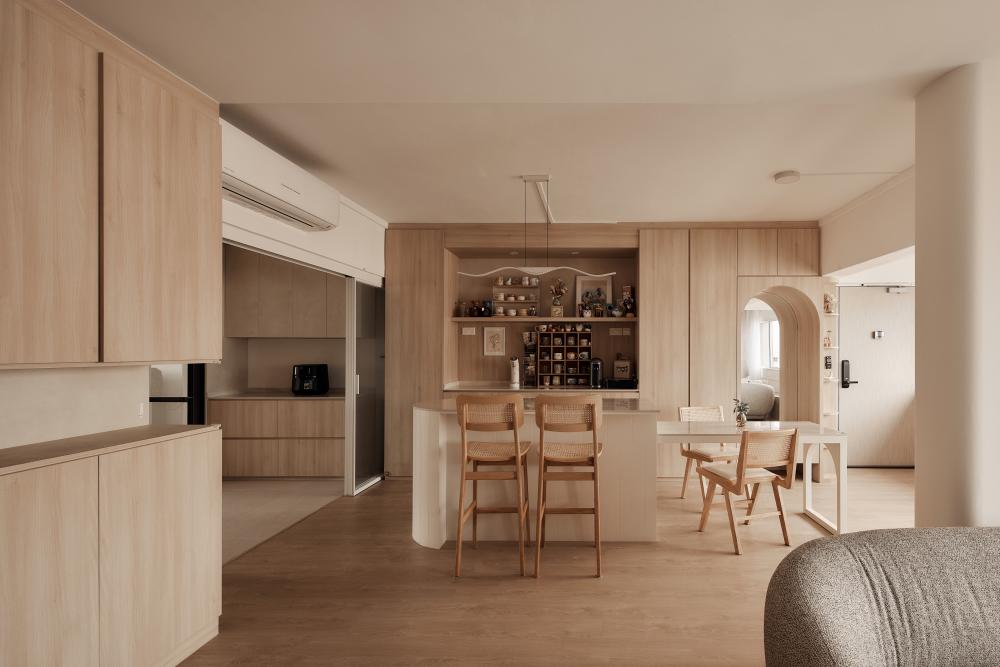

Tampines Sunrise ($68,000) by Starry Homestead Pte Ltd
Japandi furniture combines the minimalist shapes of Scandinavian design with the artisanal craftsmanship and intricate details of Japanese furniture. Japandi furniture tends to have lower profiles, with simple, but often more refined designs. There’s an emphasis on high-quality craftsmanship and creating a calming, balanced atmosphere.
Functionality and Clutter-Free Living
Scandinavian interiors are somewhat known for being clutter-free, but they also focus heavily on comfort and utility. The goal is to design spaces that are functional for everyday living, without unnecessary distractions.
While Japandi also embraces minimalism and functionality, there is often a deeper connection to mindfulness and calm. The spaces are thoughtfully curated, with each item having a purpose and meaning, sometimes making them feel even more curated than a typical Scandinavian space.
Overall Aesthetic and Atmosphere
The overall feel of a Scandinavian home is bright, airy, and practical, designed to create a cozy atmosphere known as hygge. The style prioritizes comfort, warmth, and natural light.
Japandi creates a more serene, tranquil atmosphere by balancing the simplicity of Scandinavian design with the calmness and focus of Japanese interiors. The style emphasizes balance, subtle elegance, and quiet refinement, often with fewer but more thoughtfully chosen pieces.
Budgeting for Your Scandinavian Renovation
A Scandinavian renovation doesn’t have to break the bank. With thoughtful planning and a focus on essentials, you can achieve the clean, cozy aesthetic without overspending. Here are some tips to help you stay within budget while embracing this timeless design style:
Focus on High-Impact Changes
Start with the foundational elements of the Scandinavian aesthetic – floors and walls.
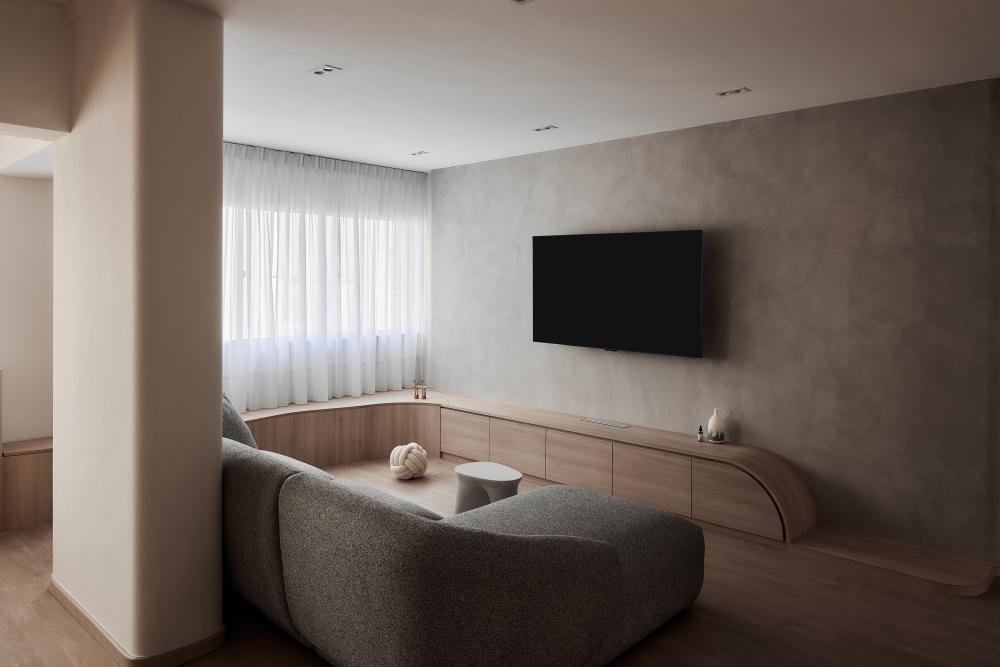

Tampines Sunrise ($68,000) by Starry Homestead Pte Ltd
Updating your flooring to light wood tones or wood-look vinyl can dramatically transform the space, creating an airy, open feel. Similarly, painting walls in neutral shades like white, light grey, or beige is a cost-effective way to refresh the entire room.
If you want more texture or personality, consider peel-and-stick wallpapers, which are both affordable and easy to change later.
Simple Upgrades Instead of Complete Overhauls
Focus on upgrading only what’s essential to achieve the Scandinavian look without the need for major overhauls.
For example, if your kitchen cabinets are too colourful or bold, there’s no need to replace them entirely. Instead, you can refresh them with a coat of paint (either as a DIY project or by hiring a professional) or apply contact paper for a more neutral finish.
Small changes like swapping out hardware for sleek, modern handles or giving old furniture a fresh coat of white paint can also help create a Scandinavian vibe without the cost of a full renovation. These simple upgrades allow you to transform your space while staying on budget.
Affordable Furniture Options
When it comes to Scandinavian design, you don’t need to splurge on designer pieces to get the look. Everyone’s favorite home furnishings store, IKEA, is Swedish and fully embodies Scandinavian design principles.
IKEA offers an extensive range of affordable, functional, and stylish furniture options for every room in the house.
Whether you need a minimalist dining table, storage solutions with clean lines, or cozy textiles, IKEA has something for everyone. Look out for multi-functional items like their popular sofa beds or foldable dining tables, which are perfect for small spaces.
Common Mistakes to Avoid With The Scandinavian Style
Renovating in the Scandinavian style may seem straightforward, but there are some pitfalls to watch out for.
Overloading on Decor
The beauty of Scandinavian design lies in its minimalism, where every item has a purpose. It’s easy to get carried away with decorative pieces, but it’s important to remember that less is more.
Too many accessories, such as excessive artwork, trinkets, or furniture, can make a space feel cluttered rather than serene.
Instead, focus on choosing a few key statement pieces that complement the neutral tones and natural materials used throughout your home. A few well-placed items, like a vase of fresh flowers or a sleek piece of art, will add personality without overwhelming the space.
Ignoring Practicality
Scandinavian design is all about blending style with function. It’s easy to fall in love with the look of beautiful furniture or décor, but don’t forget to consider how practical those choices are for your daily life.
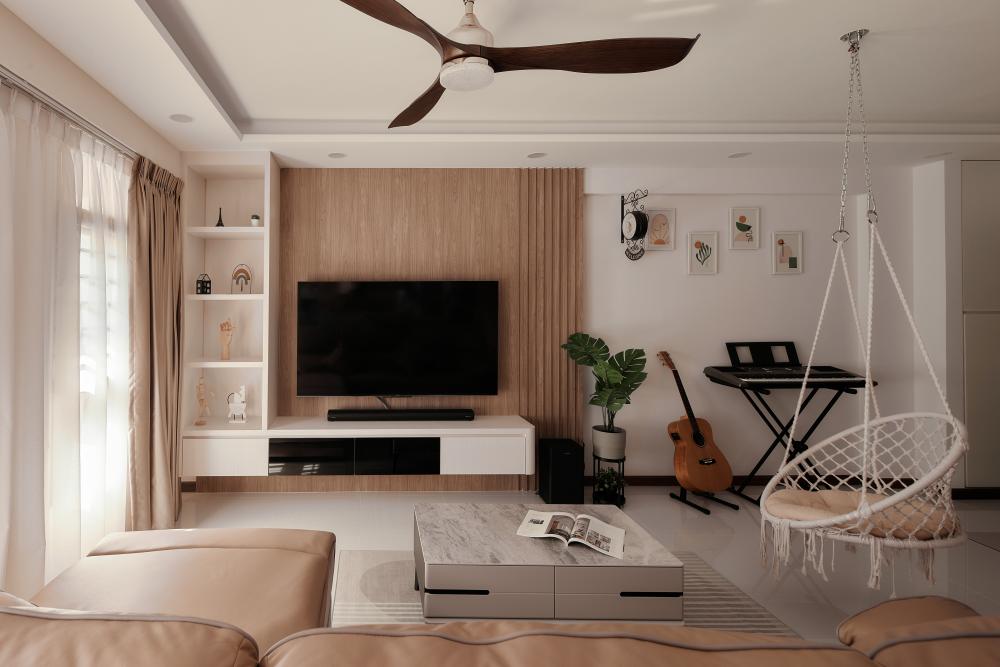

Plantation Acres ($60,000) by Starry Homestead Pte Ltd
For instance, open shelving may look lovely, but if you have a lot of items to store, it can quickly become a cluttered eye-sore.
Think about how you live and the items you use every day. Opt for furniture that’s not only stylish but also serves a clear function, such as multi-purpose pieces like storage benches or foldable tables.
In small apartments, be sure to incorporate smart storage solutions to keep your space organized and functional.
Using Only Whites
While white is a hallmark of Scandinavian design, using it exclusively can sometimes make your space feel cold or sterile. A fully white interior, especially in small spaces, may lack the warmth and character needed to make your home feel inviting.
To avoid this, balance the white with natural wood tones – think light oak floors, wooden furniture, or even a wooden accent wall. Soft textiles like wool throws, linen cushions, and knitted rugs also add texture and warmth.
Consider subtle pops of colour through accessories like a patterned rug or pastel-hued decor to create a cozy, lived-in feel.
Avoiding a Cookie-Cutter Scandinavian Apartment
Scandinavian design is often the go-to choice for young Singaporean couples looking to create a sleek, modern home. Its clean lines, neutral colour palette, and minimalist aesthetic make it easy to fall in love with.
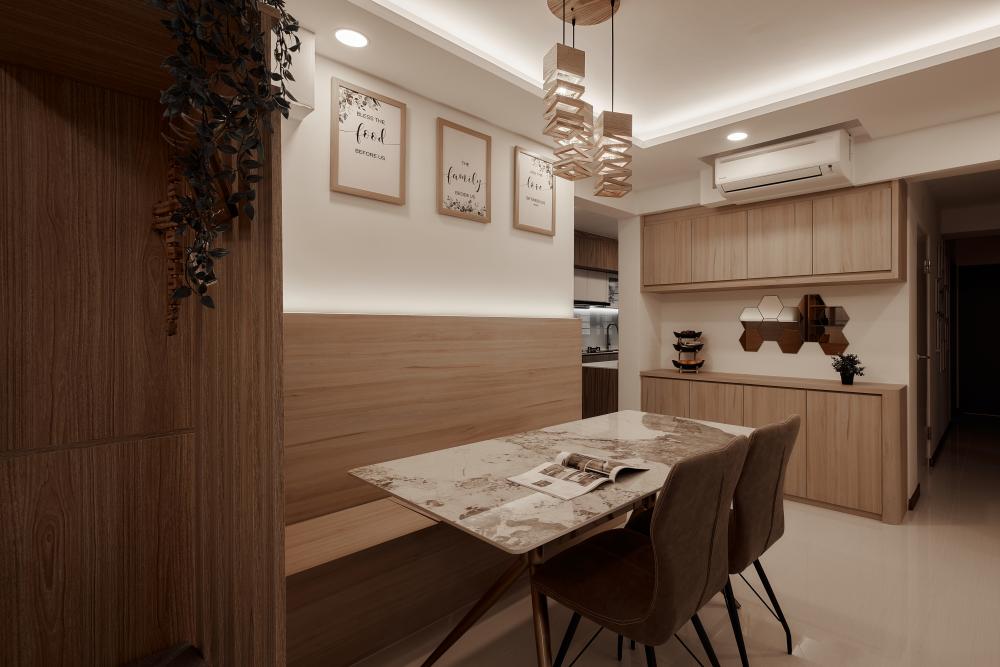

Plantation Acres ($60,000) by Starry Homestead Pte Ltd
However, when overdone, it can begin to feel predictable, sterile, or even boring – like every other Scandinavian-inspired BTO flat you’ve seen before. To truly make the space your own and avoid a cookie-cutter look, it’s important to inject personal style and creativity into the design.
Here are a few ways to keep your Scandinavian apartment from feeling too generic:
Add Unique Textures and Patterns
While Scandinavian design favors neutral tones and simple patterns, you can add depth and character by mixing textures.
Consider incorporating textured wall treatments, like a limewash wall or a soft, geometric wallpaper in muted tones.
Layering different fabrics in your cushions, throws, and rugs can also bring warmth and personality to the space. Look for breathable and lightweight textures that align with the Scandinavian aesthetic, like cotton throws, linen cushions, or jute rugs.
Personalize with Statement Art
Scandinavian spaces often rely on minimalistic art, but personalizing the art you display can really elevate the space.
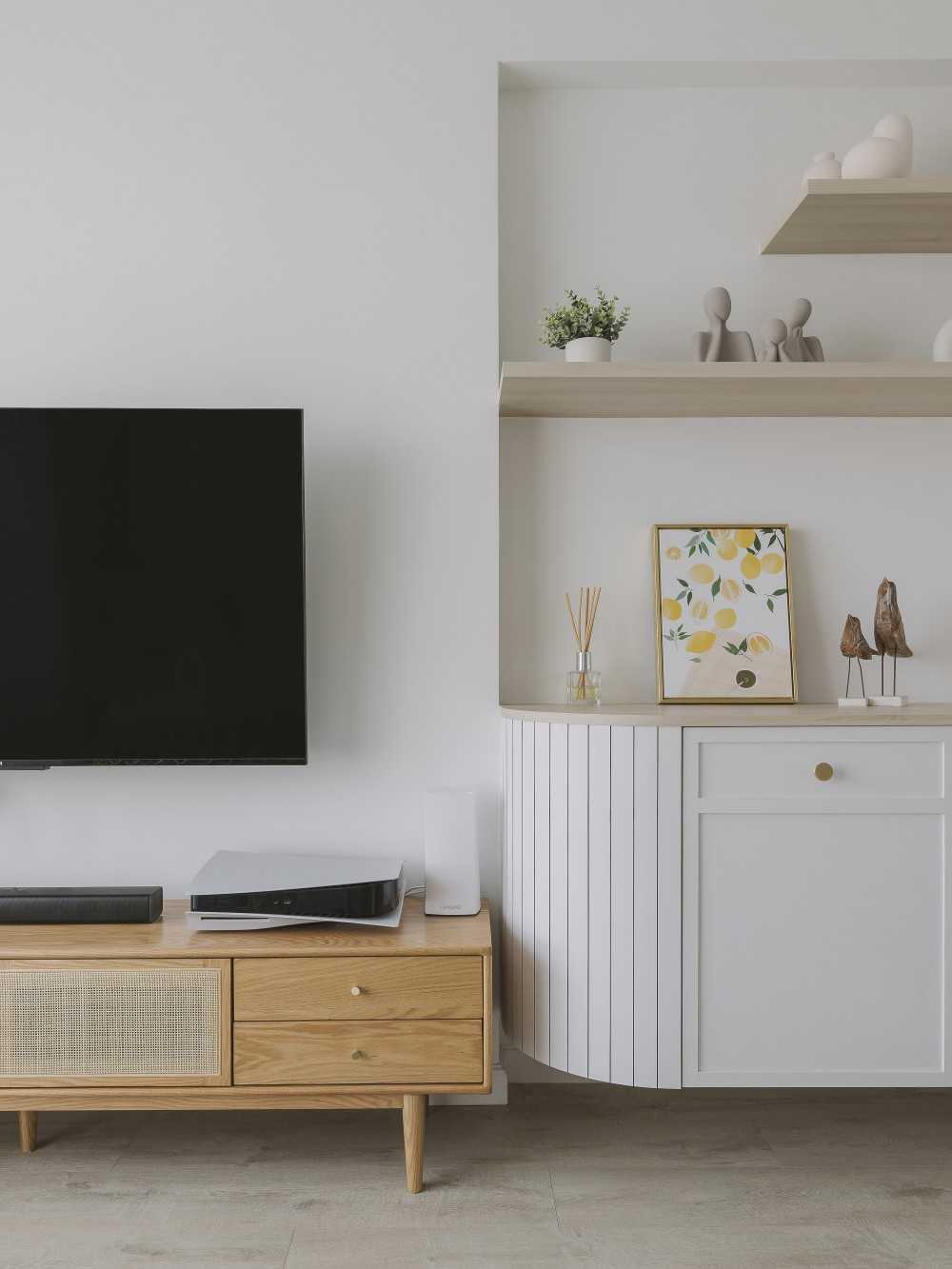

37A Pine Lane ($100,000) by The Interior Lab Pte Ltd
Look for pieces that reflect your own tastes, whether that’s abstract art, photography, or prints that have sentimental meaning to you. Consider framing personal photographs or even creating your own artwork to give the space a more unique, personal touch.
Mix Modern with Vintage
Scandinavian design is often associated with modernity, but adding vintage or antique elements can create a more unique atmosphere.
Try mixing contemporary Scandinavian furniture with retro items – perhaps a mid-century modern chair or an antique mirror. The blend of old and new will give your space more character and prevent it from feeling too curated or mass-produced.
A Final Word on Renovating in the Scandinavian Style
Scandinavian design offers a timeless, functional, and beautiful approach to home renovation that’s perfect for Singaporean living.
By embracing its principles and adapting them to your local context, you can create a space that’s not only stunning but also deeply comfortable and practical.
Ready to transform your home? Start small, plan thoughtfully, and let the simplicity and warmth of Scandinavian design elevate your living experience.
Want to explore Scandinavian home makeovers? Check out Scandinavian renovation ideas on Hometrust or click the button below to get matched with interior designers who can bring your vision to life!
Planning a Renovation? Let Hometrust Help You Find the Right Designers.
Thinking of starting your Scandinavian-style home? You’re in the right place.
At Hometrust, we connect you with top rated interior designers recommended by real homeowners based on your specific needs, preferences, and lifestyle.
Whether it’s a light makeover or full renovation, our recommendations are personalized and completely free.
Get RecommendationsWarm regards,
The Hometrust Team

